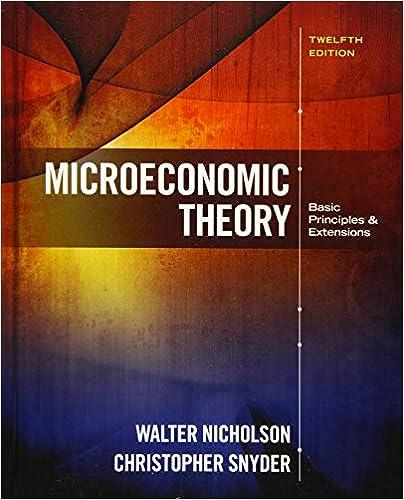The benefit function In a 1992 article David G. Luenberger introduced what he termed the benefit function
Question:
The benefit function In a 1992 article David G. Luenberger introduced what he termed the benefit function as a way of incorporating some degree of cardinal measurement into utility theory.10 The author asks us to specify a certain elementary consumption bundle and then measure how many replications of this bundle would need to be provided to an individual to raise his or her utility level to a particular target. Suppose there are only two goods and that the utility target is given by U∗ 1x, y2. Suppose also that the elementary consumption bundle is given by 1x0, y02. Then the value of the benefit function, b 1U∗2, is that value of α for which U 1αx0, αy02 5 U∗
.
a. Suppose utility is given by U 1x, y2 5 xβ
y12β
. Calculate the benefit function for x0 5 y0 5 1.
b. Using the utility function from part (a), calculate the benefit function for x0 5 1, y0 5 0. Explain why your results differ from those in part (a).
c. The benefit function can also be defined when an individual has initial endowments of the two goods. If these initial endowments are given by x, y, then b 1U ∗
, x, y2 is given by that value of α, which satisfies the equation U 1x 1 αx0, y 1 αy02 5 U ∗. In this situation the “benefit” can be either positive (when U 1x, y2 , U ∗
) or negative
(when U 1x, y2 . U∗). Develop a graphical description of these two possibilities, and explain how the nature of the elementary bundle may affect the benefit calculation.
d. C ons i d e r t wo p o s s i b l e i n it i a l e n d ow m e nt s , x1, y1 and x2, y2. Explain both graphically and intuitively why baU∗, x1 1 x2 2 , y1 1 y2 2 b , 0.5 b 1U∗, x1, y12 1 0.5 b 1U∗, x2, y22. (Note: This shows that the benefit function is concave in the initial endowments.)
Step by Step Answer:

Microeconomic Theory Basic Principles And Extensions
ISBN: 9781305505797
12th Edition
Authors: Walter Nicholson, Christopher M. Snyder






